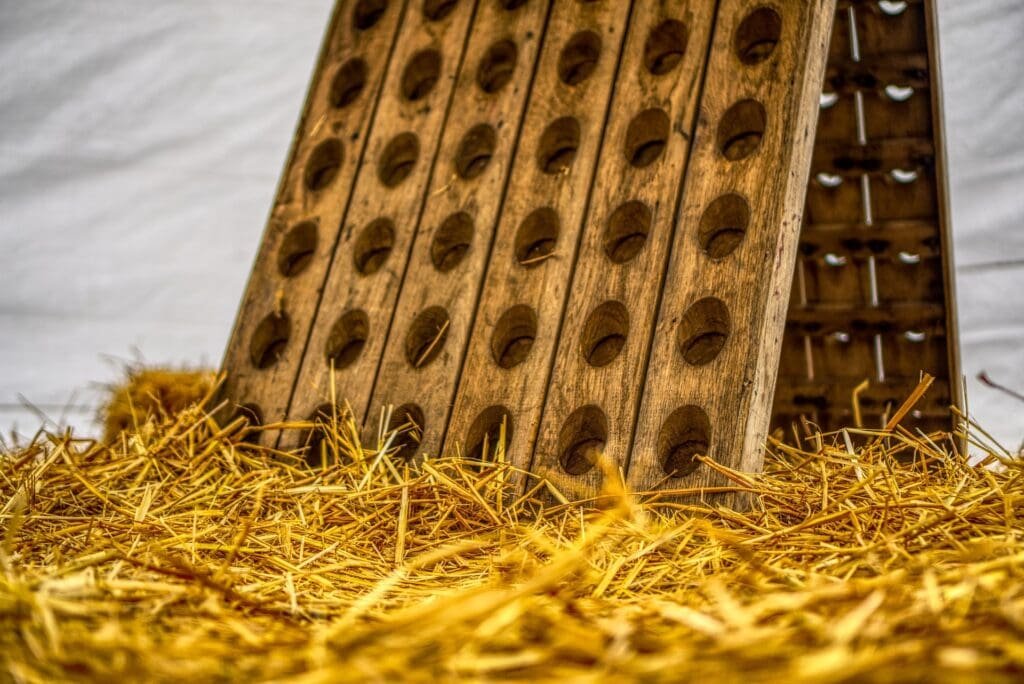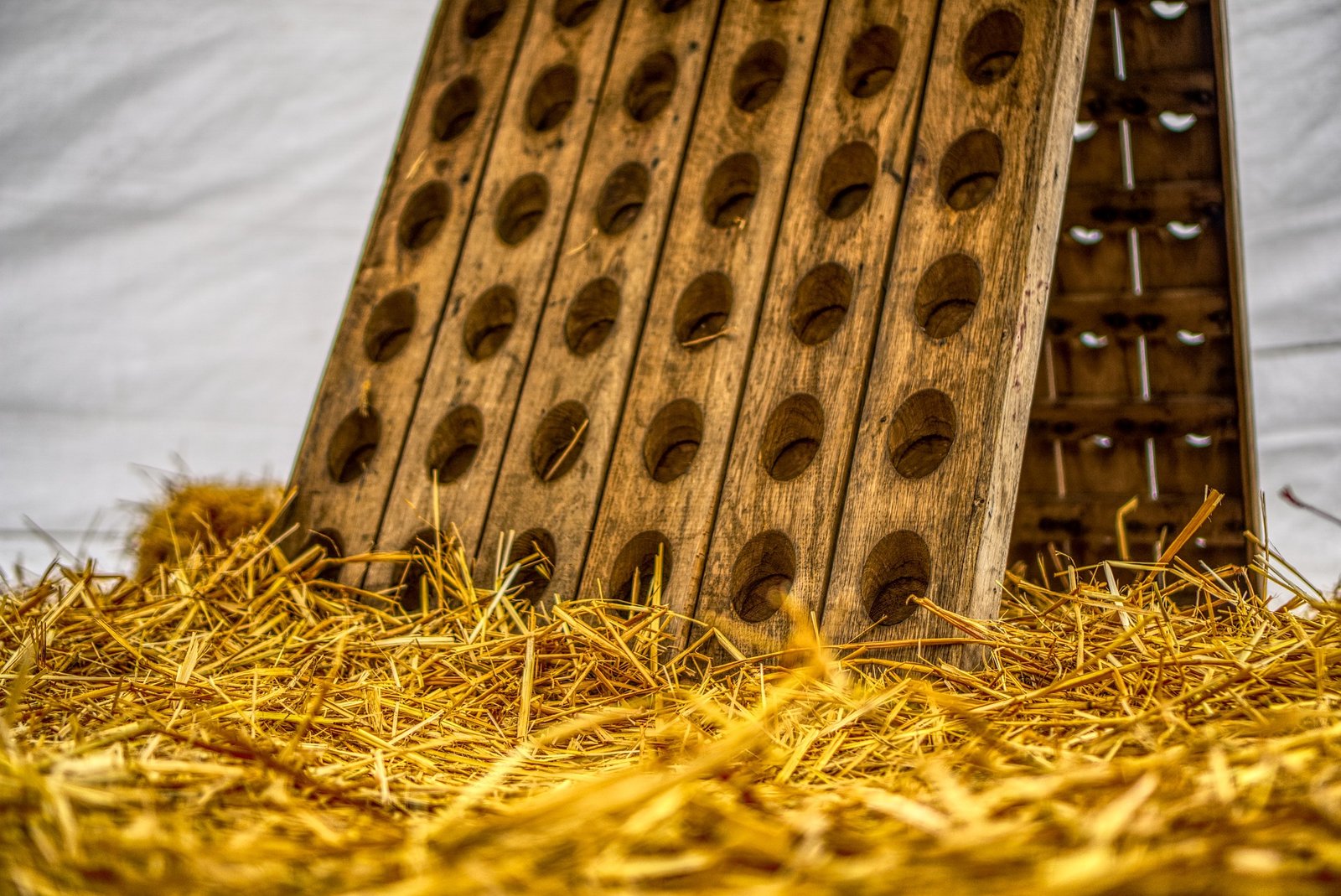In the production of sparkling wine, including the exceptional varieties from Australia, a riddling rack plays a crucial role. But, what is a riddling rack? This specially designed rack holds bottles at an angle, allowing the sediment that forms during fermentation to settle near the bottle cap.
It’s an important step in the traditional method of making sparkling wine, which is also how authentic Champagne from France is crafted. When you indulge in a flute of sparkling wine, the clarity and finesse you enjoy are partly thanks to the meticulous process of riddling.

The process revolving around a riddling rack involves gradually tilting and rotating the bottles over a period. This technique encourages the yeast and other solids to move towards the bottle’s neck, which are later expelled to ensure the final product is clear and sediment-free. As a lover of effervescent Australian wines, you might appreciate knowing that riddling is a time-honoured technique that contributes to the high quality of bubbles you savour. Whether enjoying a Tasmanian Pinot Noir or a South Australian Chardonnay-based sparkler, the influence of the riddling rack on their brilliance is substantial.
What is a Riddling Rack? The History
The riddling rack is an invention attributed to Madame Clicquot in the early 19th century, and its use revolutionised the champagne production process in the Champagne region of France. It provided an effective means of removing sediment from bottles, significantly enhancing the clarity and quality of champagne.
Madame Clicquot and the Champagne Region
Madame Clicquot, a pioneering French businesswoman, is credited with inventing the riddling rack around 1816. This innovation addressed the problem of cloudy champagne caused by residual yeast and sediment that collected in the bottle during the second fermentation. By positioning bottles at a 45-degree angle, sediment would move towards the bottle’s neck, ready to be extracted. This technique bestowed the Champagne region of France with a new tradition that became essential to producing exquisite, clear champagne.
Evolution of the Riddling Process
Riddling, or ‘remuage’ in French, eventually transitioned from manual labour to mechanisation. Initially, workers called ‘remueurs’ would manually turn each bottle fractionally every day and progressively make the bottle shift from a horizontal to a near-vertical position that pointed downward. This culmination of history, tradition, and innovation in France’s Champagne region has stood the test of time. Today, while automated riddling racks are used in many wineries, the essence of the traditional process remains the same, especially when producing vintage champagnes that adhere to strict quality standards.
Understanding Riddling in Winemaking
When you indulge in a glass of sparkling wine, know that a delicate and critical step called riddling has played a part in its journey to your glass.
Role of Riddling in Sparkling Wine Production
Riddling is a vital process in the production of sparkling wine. It involves the gradual shifting of yeast sediment, which accumulates during the secondary fermentation, to the neck of the bottle. This technique ensures the clarity and purity of your sparkling wine, as the sediment is ultimately removed during disgorgement. Australian sparkling wines, such as those from Tasmania, often undergo this meticulous procedure to achieve their renowned brilliance and effervescence.
The Traditional Method and Remuage
In the traditional method, known as méthode traditionnelle, remuage or riddling is performed manually. Bottles are placed in a riddling rack at a 45-degree angle, with the cork pointed down. Each day, skilled workers turn the bottles a small degree and slightly increase the tilt. This action, done over several weeks, encourages the yeast to settle near the bottle cap. Once completed, the yeast is expelled in a process called disgorgement, leaving behind a pristine sparkling wine for you to enjoy.
Design and Operation of Riddling Racks
Riddling racks play a crucial role in the traditional method of producing sparkling wines, requiring precision in both their design and usage.
Materials and Craftsmanship
Your riddling rack is typically crafted from high-quality French Oak, showcasing expert woodworking skills. The wood is either left natural or treated with a stain or paint to protect it and enhance its appearance. Each rack consists of two hinged rectangular panels with holes cut precisely to hold the neck of champagne bottles at the necessary angle, enabling sediment to settle.
The Riddling Process Step by Step
The riddling process begins with bottles placed horizontal on the rack. Over time, through a methodical technique, you’ll apply gentle pressure and angle the bottles downwards, inducing the lees or sediment to migrate towards the bottle’s cap. This gradual maneuvering is critical, usually culminating with the bottles being positioned upside down to gather all sediment at the neck, ready for disgorging.
Modern Innovations and Alternatives
In your exploration of wine storage techniques, you’ll find that traditional riddling racks have evolved. Technological advancements have introduced automation in the riddling process, enhancing efficiency and accuracy.
Transition to Gyropalette
The gyropalette, a significant advancement in wine production, has revolutionised the traditional method of riddling. This mechanical system simulates the manual twisting and turning of bottles but on a much larger scale. By using vibration and gentle rotation, gyropalettes can handle several hundred bottles at a time, ensuring uniform sediment collection and ultimately clearer Australian sparkling wines without the intensive labour.
Automated Riddling Machines
Automated riddling machines have further transformed the wine industry. These machines employ advanced technology to replicate the complex motions that were once done by hand. With precise control over vibration and rotation speed, these devices ensure consistency in your sparkling Shiraz or Chardonnay. The level of automation provides a significant advantage for large-scale producers, minimising manual intervention and maximising productivity.
Riddling Racks Beyond the Cellars
Riddling racks, once confined to the process of winemaking, have found new life in homes and as gifts. In addition to their practical use in refining sparkling wines, these racks have become a stylish element in decor and a thoughtful present for wine lovers.
Decorative Uses and Unique Gift Ideas
Decor: Riddling racks are not just for cellars anymore. You can incorporate these wooden structures into your home decor to create a rustic and charming atmosphere. They serve as inventive shelving for books, display frames, or house plants. For a more personalised touch, place a riddling rack in your dining area to show off your collection of Australian varietals such as Shiraz or Chardonnay.
Unique Gift Ideas: If you’re on the hunt for a one-of-a-kind present, consider a riddling rack. Whether you’re shopping on Etsy or local craft markets, you can find handcrafted riddling racks that make for an unexpected gift. Ideal for wine enthusiasts, these racks can be customised to add a personal flair. Pair it with a set of fine Australian Pinot Noir or a Cabernet Sauvignon to elevate the offering.
Remember, a riddling rack’s use extends beyond the wine cellar. As you set out to refresh your decor or search for that unique gift, keep these versatile racks in mind.
Frequently Asked Questions
Riddling racks are an essential tool in traditional winemaking, especially for the production of sparkling wines. They facilitate the process of riddling, which is crucial for clarity and quality of the final product.
How is a riddling rack utilised in winemaking?
A riddling rack is used during the winemaking process to help clear wine of sediment. Bottles are placed at an angle into holes on the rack and gradually rotated by hand to encourage yeast and small particles to settle in the neck of the bottle.
For what purpose are riddling racks employed with champagne?
Champagne undergoes a secondary fermentation in the bottle, producing sediments. Riddling racks hold the bottles at a specific angle to gradually move these sediments towards the bottle’s cap, preparing them for removal in a step known as disgorgement.
From what materials are riddling racks typically constructed?
Traditionally, riddling racks are made from wood, such as French Oak. They consist of two hinged rectangular boards with holes to hold the bottles. However, some modern variants may use metal for added durability.
Could a riddling rack serve as a storage solution for wine bottles?
While riddling racks are designed for the riddling process rather than storage, they can be repurposed as an attractive and functional storage solution for your wine bottles, especially if you prefer to display them in a unique way.
How does riddling contribute to the winemaking process?
Riddling aids in developing the wine’s clarity and purity by removing unwanted sediments. It’s a time-honoured technique that ensures sparkling wines, like those from Australian regions, are of the highest quality when they reach your glass.
What steps are involved in using a riddling rack effectively?
To use a riddling rack, you insert the wine bottles neck-down into the rack. Over time, you rotate them incrementally by hand. This movement helps to consolidate the sediment towards the neck, ready for disgorgement, without disturbing the wine’s delicate balance.
User Review
( vote)Sip smarter, subscribe now!
Subscribe for gourmet tips, event updates, travel ideas, and a free e-book on Food Pairings. Start your journey to culinary and travel excellence!













